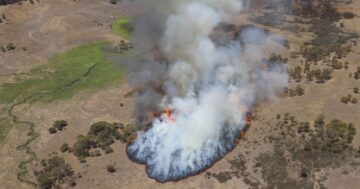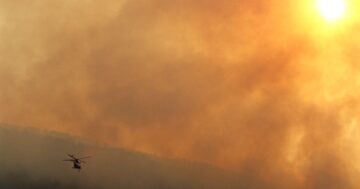
The Orroral Valley fire burnt nearly 80 per cent of the Namadgi National Park. Photo: Gary Hooker.
The crew of the Australian Defence Force helicopter which accidentally started the Orroral Valley fire with a faulty landing light did not pass on the fire’s location to authorities for 45-minutes, sparking confusion as frantic firefighters scrambled to locate the fire and respond.
Internal Defence logs obtained by the ABC revealed that the damaged helicopter flew 40 kilometres to Canberra Airport – as opposed to a closer Emergency Services Agency (ESA) base – and crews were issued with a “blackout message” to “advise no external comms regarding work activities” just minutes after landing.
A Defence reporting timeline shows that the crew did not pass on the location data until they had landed at about 2:15 pm.
The aircrew’s priority was the safety of the crew and the aircraft, a Defence spokesperson said.
“At the time of the ignition, the Australian Defence Force MRH-90 Callsign ANGEL 21 was damaged and in an emergency situation. The aircrew’s priority was to return the aircrew and aircraft to safety,” the spokesperson said.
“The aircrew passed the location of the fire to ACT Emergency Services Agency immediately after effecting an emergency landing at Canberra Airport.”
However, the ABC is also reporting that Defence was concerned about possible reputational damage from the fire.
The Department of Defence confirmed results of an investigation into the helicopter that sparked the Territory’s worst fire season since 2003 will not be released.
“This absence appears to be a result of aircrew and unit focus on the safety of personnel still in active fire field and reputational impact to the ADF,” a later ministerial brief said.
It took the ESA 17-minutes to spot smoke from the nascent fire at its Mount Tennent fire tower and the location was finally confirmed by a spotter aircraft around 48 minutes after ignition and 29 minutes after the smoke has been seen.
Just 10 minutes after the helicopter crew started to notify authorities, Rural Fire Service members were standing back because of the fire’s size.
“I do not think there is much we can do,” one member said at 2:24 pm, according to radio logs.
It eventually burnt 78 per cent of the Namadgi National Park and 22 per cent of Tidbinbilla.

A Very Large Airtanker (VLAT) was called in to help establish containment lights around Tharwa. Photo: Gary Hooker.
Former ACT Emergency Services Commissioner Peter Dunn said that speed was a crucial factor in responding to fires during catastrophic conditions.
“[You need to have] a response within one-hour of ignition and that response is aircraft with fire retardant and dropping remote area firefighting teams in,” he said.
“If we do not learn to respond to the initial circumstances differently then the fires will get away because we are going to have terribly dry landscapes and they will run.”
An ESA spokesperson said that units were activated as soon as the fire tower confirmed the location of the blaze, and that two aerial resources were activated three minutes later.
“The nature of the event, weather, topography, and dry environmental conditions meant the spread of the Orroral Valley fire was driven by various environmental factors that made suppressing the fire extremely challenging,” the spokesperson said.
“The community should be reassured that the ACT ESA did all that they could to reduce the spread of the Orroral Valley Fire as quickly as possible.”
Mr Dunn said the incident reaffirms the Royal Commission’s recommendation that Australia have its own sovereign firefighting fleet. The Very Large Air Tanker, or VLAT, was sent down from the Richmond Air Base north-west of Sydney, costing crucial time.
“With 45-minutes you still have 15-minutes to respond – if they had an aircraft sitting on the deck they could have but they did not have that,” he said.
Defence did not confirm that the helicopter was the source of the ignition to ESA Commissioner Georgeina Whelan or Chief Minister Andrew Barr until the following afternoon, despite having talking points that were fact-checked and ready for release by 5:20 pm.
The documents said that the “ACT ESA were informed of the location of the fire as soon as practicable”.
The ESA says it is satisfied with the flow of information with Defence.
“The ACT ESA is satisfied that the ADF followed their safety protocols in relation to reporting of the incident and that the information flow was consistent and appropriate between ACTESA and ADF,” an ESA spokesperson said.














